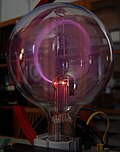Cathode ray
A cathode ray is a stream of electrons that are seen in vacuum tubes. It is called a "cathode ray" because the electrons are being emitted from the negative charged element in the vacuum tube called the cathode. A cathode ray tube aims the ray at a point on its screen. They were first observed in 1869 by German physicist Johann Hittorf, and were named in 1876 by Eugen Goldstein Kathodenstrahlen, or cathode rays.[1][2]
Electrons were discovered as the constituents of cathode rays in 1897 by British physicist J. J. Thomson. He showed the rays were composed of a previously unknown negatively charged particle, which was later called the electron. Cathode ray tubes (CRTs) use a focused beam of electrons deflected by electric or magnetic fields to create the image in a classic television set.
Some properties of cathode rays:
- They travel in a straight path.
- They have a negative electric charge
- They have particle property
- Magnets can deflect them
- Charge/mass ratio of the rays is constant
- They travel from the cathode to the anode
- Their properties are independent from the electrodes and gas present in the cathode ray tube.
- Cathode rays can ionize gas
- The travel more slowly than light
- They can heat objects that they hit
- They can penetrate through thin Aluminium plates
- They can make phosphors glow
Cathode Ray Media
A beam of cathode rays in a vacuum tube bent into a circle by a magnetic field generated by a Helmholtz coil. Cathode rays are normally invisible; in this demonstration Teltron tube, enough gas has been left in the tube for the gas atoms to luminesce when struck by the fast-moving electrons.
A diagram showing a Crookes tube connected to a high voltage supply. The metal Maltese cross in the tube, with no external connection to the circuit, casts a shadow on the glowing wall.
Glow discharge in a low-pressure tube caused by electric current.
J. J, Thomson's electric deflection tube, in which he showed that a beam of cathode rays was bent by an electric field like matter particles. The cathode is on R. The electron beam is accelerated passing through the cylindrical high voltage anode (center), bent by a voltage on the deflection plates (center L), and strikes the back wall of the tube causing a luminous glow.
References
- ↑ Goldstein E. 1876. "Vorläufige Mittheilungen über elektrische Entladungen in verdünnten Gasen" (Preliminary communications on electric discharges in rarefied gases), Monatsberichte der Königlich Preussischen Akademie der Wissenschaften zu Berlin (Monthly Reports of the Royal Prussian Academy of Science in Berlin), 279-295. From page 286: "13. Das durch die Kathodenstrahlen in der Wand hervorgerufene Phosphorescenzlicht ist höchst selten von gleichförmiger Intensität auf der von ihm bedeckten Fläche, und zeigt oft sehr barocke Muster." (13. The phosphorescent light that's produced in the wall by the cathode rays is very rarely of uniform intensity on the surface that it covers, and [it] often shows very baroque patterns.)
- ↑ Keithley, Joseph F. 199. The story of electrical and magnetic measurements: from 500 B.C. to the 1940s. London: John Wiley, page 205. ISBN 0-7803-1193-0
+{{{1}}}−{{{2}}}









